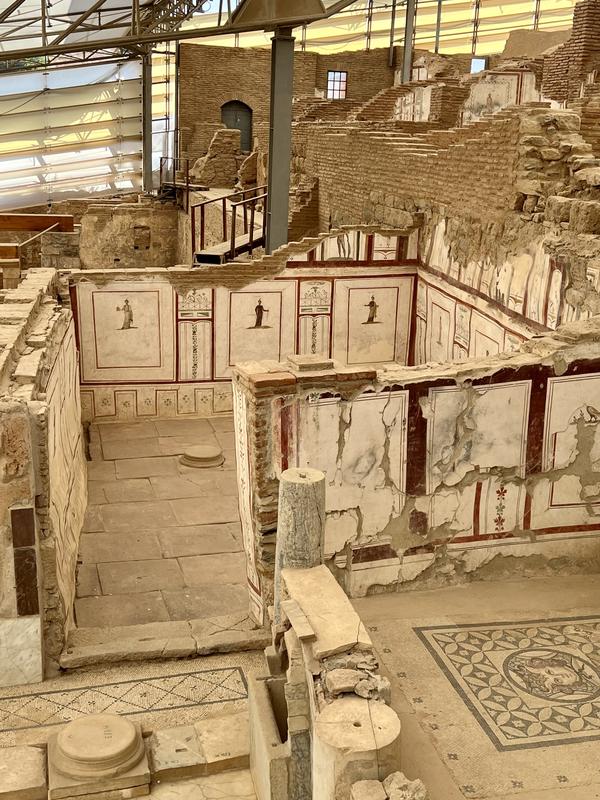Nestled in the heart of modern-day Turkey, Ephesus stands as a testament to the enduring legacy of classical antiquity. Once a bustling metropolis of the ancient Greek and Roman world, Ephesus flourished as a center of culture, commerce, and spirituality. Today, its well-preserved ruins attract visitors from around the globe, offering a captivating glimpse into the rich history and architectural marvels of one of the ancient world’s greatest cities.

A City of Greek Origins
Ephesus traces its origins back to the Ionian Greeks, who settled in the area around the 10th century BC. Located near the western coast of Asia Minor, Ephesus benefited from its strategic location along major trade routes, connecting it to the Aegean Sea and beyond. The city grew rapidly, becoming one of the largest and most important Greek cities of antiquity.

During the 6th century BC, Ephesus thrived under the rule of the Lydian Empire and later came under Persian control. Despite political changes, Ephesus continued to prosper economically and culturally, attracting settlers from various parts of the Mediterranean world. The city’s strategic position and fertile surroundings ensured its prominence as a hub of trade and intellectual exchange.
Roman Influence and Imperial Grandeur
By the 2nd century BC, Ephesus came under Roman rule and experienced a period of unprecedented growth and prosperity. The Romans recognized Ephesus’ strategic importance and invested heavily in its infrastructure, transforming the city into a major urban center. Under Roman rule, Ephesus became the capital of the Roman province of Asia and thrived as a cosmopolitan city with a diverse population.

One of the most iconic structures of Roman Ephesus is the Library of Celsus, built in the 2nd century AD. This impressive library, dedicated to the Roman Senator Tiberius Julius Celsus Polemaeanus, housed thousands of scrolls and served as a symbol of the city’s intellectual and cultural achievements. The facade of the library, adorned with intricate statues and reliefs, remains a striking example of Roman architectural splendor.
Cultural and Religious Significance
Ephesus was not only a center of trade and governance but also a hub of religious diversity and spiritual significance. The city was home to the Temple of Artemis, one of the Seven Wonders of the Ancient World. Dedicated to the Greek goddess Artemis, the temple attracted pilgrims from across the Mediterranean and beyond, contributing to Ephesus’ reputation as a sacred city.

Christianity also flourished in Ephesus, particularly following the ministry of the Apostle Paul in the 1st century AD. The New Testament Book of Ephesians is believed to have been written to the Christian community in the city, highlighting its importance in early Christian history. The House of the Virgin Mary, located near Ephesus, is traditionally ᴀssociated with Mary, the mother of Jesus, adding to the city’s religious significance and drawing pilgrims to its ancient shores.
Architectural Marvels and Urban Layout
The layout of ancient Ephesus reflects its status as a major urban center of the ancient world. The city was meticulously planned, with broad, colonnaded streets, public squares, and impressive public buildings. The Great Theater of Ephesus, one of the largest ancient theaters with a seating capacity of over 25,000 spectators, exemplifies the city’s architectural prowess and served as a venue for theatrical performances, political gatherings, and religious ceremonies.
Ephesus’ urban planning also included sophisticated water and sewage systems, underscoring the city’s advanced engineering capabilities. The presence of public baths, temples, and marketplaces further attests to Ephesus’ status as a vibrant cosmopolitan center where commerce, culture, and civic life intersected.
Rediscovery and Preservation
The decline of Ephesus began in the 3rd century AD, as shifting trade routes and geopolitical changes contributed to its gradual decline. The city was eventually abandoned and fell into obscurity, its ruins buried beneath layers of sediment and vegetation over the centuries.
Ephesus’ rediscovery began in the 19th century with archaeological excavations that unearthed its ancient treasures. Today, Ephesus is a UNESCO World Heritage Site and one of Turkey’s most visited tourist destinations. Visitors to Ephesus can explore its well-preserved ruins, including the Library of Celsus, the Temple of Artemis, and the Great Theater, marveling at the remnants of an ancient city that once epitomized the grandeur and sophistication of Greco-Roman civilization.
Conclusion: Ephesus, an Enduring Legacy
Ephesus stands as a testament to the resilience of human achievement and the enduring legacy of ancient civilizations. From its humble beginnings as a Greek settlement to its zenith as a Roman metropolis, Ephesus embodies the cultural richness, architectural splendor, and spiritual significance of the ancient world. Its well-preserved ruins continue to inspire awe and admiration, offering a window into the past and a deeper understanding of the complexities of ancient urban life.
As visitors wander through the streets of Ephesus, they are transported back in time, encountering remnants of grand temples, bustling marketplaces, and majestic theaters. The city’s legacy lives on in its archaeological treasures and in the enduring influence of Greco-Roman culture on modern society. Ephesus remains not only a testament to the past but also a beacon of cultural heritage and historical exploration, inviting travelers to uncover its secrets and marvel at its enduring grandeur.

